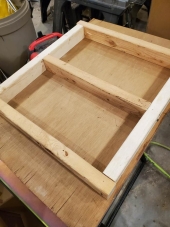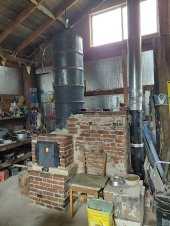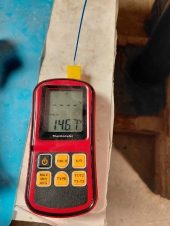


Glenn Littman wrote:Once the system is fully dry it will be interesting to know the firing cycles to get it up to temperature and maintain it considering the enormous mass. It will also be interesting to see how it retains the heat over the 35-40 hours that the store is closed and the external temperature when they reopen on Monday.

Matt Todd wrote:
Fox James wrote:Sounds good apart from putting super wool in your oven, that is not a good idea due to the risk of microscopic fibres being ingested!
Super wool is the mineral based safe alternative to Kaowool and Ceramic wool. I would still probably rigidize it though! Or perhaps use vermiculite board.

Glenn Littman wrote:
The other piece that you haven't mentioned that fits in nicely here is the time commitment. This is not a minor undertaking. My build took me roughly 3 months but being a compulsive perfectionist with my projects and having the luxury of being retired I took my good old time. Tom Rubino can comment on expected time frames to build since he has built so many over the years, both by himself and with the help of Gerry Parent (that's an advertisement for you Gerry in case you want to hire out as a professional batch rocket scientist). So, the builder needs to plan their time accordingly and have the available time to commit.

Jackson Bradley wrote:I get somewhat confused on the longevity of the different parts for the different types.
I can't quite wrap my head around what I'll need to replace/clean, about how often it will need replaced. That seems to depend on the type of RMH. I have read through your masonry build in the large building, the Wisner's materials, Thomas Rubino's projects, etc. I have seen where some of the metal components need to be replaced and some of the bricks crack and need replaced, etc.
I understand a factor of that would be climate dependent due to the amount it would be used (wood burned). The larger masonry heaters seem like what I would work up to in my residence but practice building one on in my accessory building.


Glenn Herbert wrote:I agree that a ducted mass would continuously lose heat with any amount of residual draft. I think a stratification chamber would be more dependent on details of the configuration. If the combustion core exit (riser top or secondary chamber exit port) is near the top of the stratification chamber, then it will be introducing cooler air and diluting all the stratified hot air remaining. If the core exit is low in the stratification chamber, it can move more directly to the chimney exit and leave the hot upper part of the chamber undisturbed. This is assuming that draft is restricted from full burn-time flow and does not "jet" at all.



Matt Todd wrote:
thomas rubino wrote:
I am very happy to report the highest temps my arch has risen to are just over 400F!!! (Success!)
Do you have any measurement on what your core exhaust temperature is reading?
Reason I ask is, I'M BUILDING A SHORTY IN A BRICK BELL TOO!
One final detail I'm working out is the internal chimney. Planning to do the "plunger tube" style of chimney into the bell. But my Shorty core will flip the exhaust to shoot out the back wall of the riser stub so I can put an oven on top of the firebox. The potential issue being hot exhaust shooting horizontally right at my plunger tube. My DSR2 build has a black stove pipe plunger tube and I intend to do the same here. Just a little worried about it being directly in the exhaust path.